Embarking on your guitar journey and dreaming of effortlessly navigating chord progressions and composing your own music? The prospect of building a vast chord vocabulary might seem daunting, perhaps a skill achievable only after years of dedicated practice. However, fret not! This guide will introduce you to 10 indispensable guitar chord forms that will serve as a cornerstone in your playing, applicable across diverse musical styles and scenarios.
The beauty of learning chords as “shapes” lies in its efficiency. Instead of memorizing dozens upon dozens of individual chords, you can grasp a handful of fundamental shapes and realize their versatility in creating a multitude of chords. Mastering these forms significantly accelerates your learning curve and enhances your ability to visualize chord progressions and transitions fluidly on the fretboard.
Power Chords: The Rock Guitar Foundation
Power chords are the bedrock of rock guitar. Listen to virtually any rock anthem, and you’re bound to hear these chords driving the rhythm.
A power chord, in its simplest form, is a dyad, comprising only two distinct notes: the root and the fifth. Often, a third note, an octave of the root, is added for fullness. The chord’s identity is determined by its root note – the lowest pitched note in the voicing. For instance, placing a power chord shape with its root on the 5th fret of the low E string produces an A power chord, commonly denoted as A5.
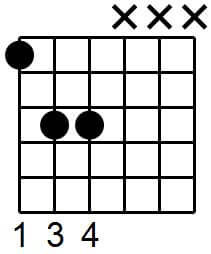 Power chord, A5 chord
Power chord, A5 chord
This adaptable shape can also be rooted on the A string for different voicings and tonal colors:
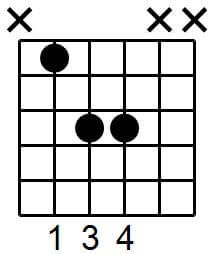 shape rooted on the A string
shape rooted on the A string
And even the D string, further expanding your power chord vocabulary across the neck:
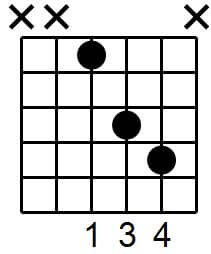 shape rooted on the D string
shape rooted on the D string
6-String Major Barre Chords: Unlock Full Voicings
Barre chords, often initially perceived as challenging, involve using one finger to press down all six strings at a specific fret. While they might seem intimidating at first, mastering barre chords unlocks a world of harmonic possibilities across the guitar neck.
The 6-string major barre chord shape is fundamentally derived from an open E major chord. If you form an E major chord using your second, third, and fourth fingers in the open position, you’ll notice your first finger is free. By shifting this hand shape up the neck, your index finger becomes available to “bar” across all six strings, effectively replacing the nut of the guitar and transposing the E major shape to higher pitches. Like power chords, barre chords, and all subsequent chord forms in this lesson, are named after their root note.
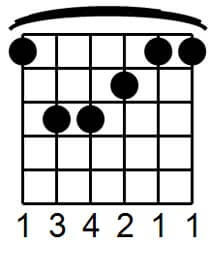 6 string major barre chord is essentially an Emaj chord
6 string major barre chord is essentially an Emaj chord
6-String Minor Barre Chords: Adding Melancholy Tones
The distinction between a 6-string major barre chord and its minor counterpart lies in a single note: the major third. This crucial note, in the major barre chord shape, is typically played by your middle finger on the G string.
To transform a major barre chord into a minor barre chord, you need to “flatten” this major third – lowering its pitch by a semitone (one fret). In the context of this shape, the flattened third is already present within the barre of your index finger. Therefore, to create a minor barre chord, simply remove your middle finger from the G string. This resulting chord form closely resembles an open E minor chord shape, barring the first fret.
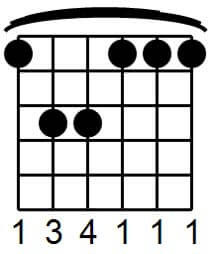 chord form resembles that of an Emin chord
chord form resembles that of an Emin chord
5-String Major Barre Chords: Rooted on the A String
Major barre chords can also be constructed with their root note on the A string (5th string). This 5-string major barre chord shape is based on the open A major chord form. It can be a slightly more intricate shape initially, so consider exploring video demonstrations for helpful shortcuts and techniques, readily available on platforms like the Blackstar Youtube channel.
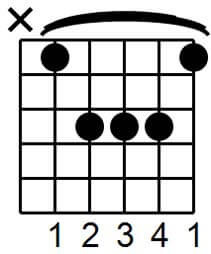 chord takes the form of an Amaj chord
chord takes the form of an Amaj chord
5-String Minor Barre Chords: A-String Rooted Minor Voicings
Just as with the 6-string barre chord variations, you can effortlessly convert a 5-string major barre chord into a minor chord by altering a single note – the major third. In this 5-string shape, the major third is located on the B string. By flattening this note, achieved naturally by the barre, the chord transforms into a minor barre chord, mirroring the shape of a standard open A minor chord, but transposed and barred.
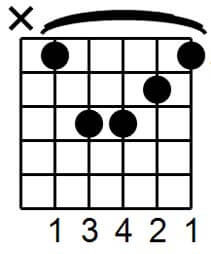 a regular Amin chord
a regular Amin chord
6-String Dominant 7 Chords: Injecting Bluesy Flavor
Dominant 7th chords are invaluable for adding a bluesy or jazzy dimension to your chord progressions. This 6-string dominant 7th chord form is elegantly simple: it’s essentially a regular 6-string major barre chord with the little finger removed. The note typically played by the little finger is an octave of the root note. In dominant 7th voicings, this octave root can be omitted to make space for the characteristic b7th (flat 7th) interval, lending the chord its dominant 7th quality.
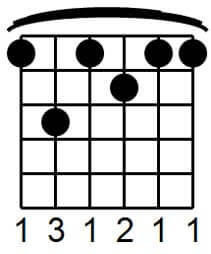 an octave of the root note
an octave of the root note
5-String Dominant 7 Chords: A-String Rooted 7th Chords
Mirroring the 6-string version, the 5-string dominant 7th chord is derived from the 5-string major barre chord shape (A-shape). To create the dominant 7th, the middle finger note is “dropped” or removed, effectively introducing the b7th interval into the voicing.
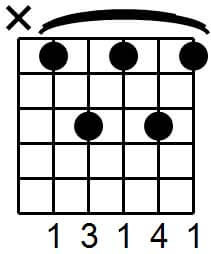 an Amaj chord type with the middle note dropped to make it a b7
an Amaj chord type with the middle note dropped to make it a b7
6-String Minor 7 Chords: Sophisticated Minor Sounds
While dominant 7th chords contain a major third interval, which might suggest a major tonality, they function distinctly within harmonic contexts. To create minor 7th chords, you flatten the major third, transforming the chord into a minor quality. The 6-string minor 7th shape is derived from the 6-string dominant 7th shape. Simply remove the middle finger, which was previously playing a note on the G string, to flatten the third and achieve the minor 7th sound.
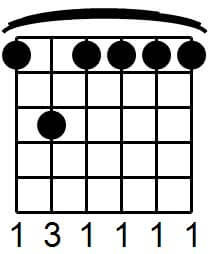 dom7 with the middle finger note on the G removed
dom7 with the middle finger note on the G removed
5-String Minor 7 Chords: A-String Minor 7th Voicings
This principle of flattening the major third to create a minor 7th chord is equally applicable to the 5-string barre chord shapes. By applying the same modification to the 5-string dominant 7th form, you obtain a 5-string minor 7th chord voicing.
 string version by flattening the major third
string version by flattening the major third
7#9 Chords (The Hendrix Chord): Unleash Funky Blues Rhythms
The final chord form in this essential collection is the 7#9 chord, famously known as the “Hendrix chord” due to its prominent use by Jimi Hendrix. This chord adds a distinctive funky and bluesy flavor to your playing.
While the “7” in its name suggests a dominant 7th chord, the 7#9 chord is essentially a re-voiced dominant 7th with an added sharp 9th interval. The voicing typically involves the root on the A string, the major third on the D string, and the b7th on the G string. Notably, it omits the 5th interval found in a standard dominant 7th chord. The characteristic #9 interval is introduced by the note played on the B string. This chord is particularly effective for funky rhythms and blues-infused progressions.
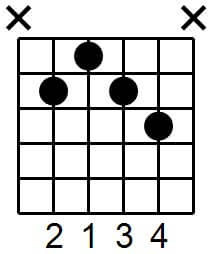 7#9 chord, otherwise known as the Hendrix chord
7#9 chord, otherwise known as the Hendrix chord


